Lunch with... Riccardo Patrese
His Formula 1 career lasted a remarkable 17 seasons, during which there were some dark moments but also six well-deserved wins. And through it all, Patrese emerged as one of the good guys.
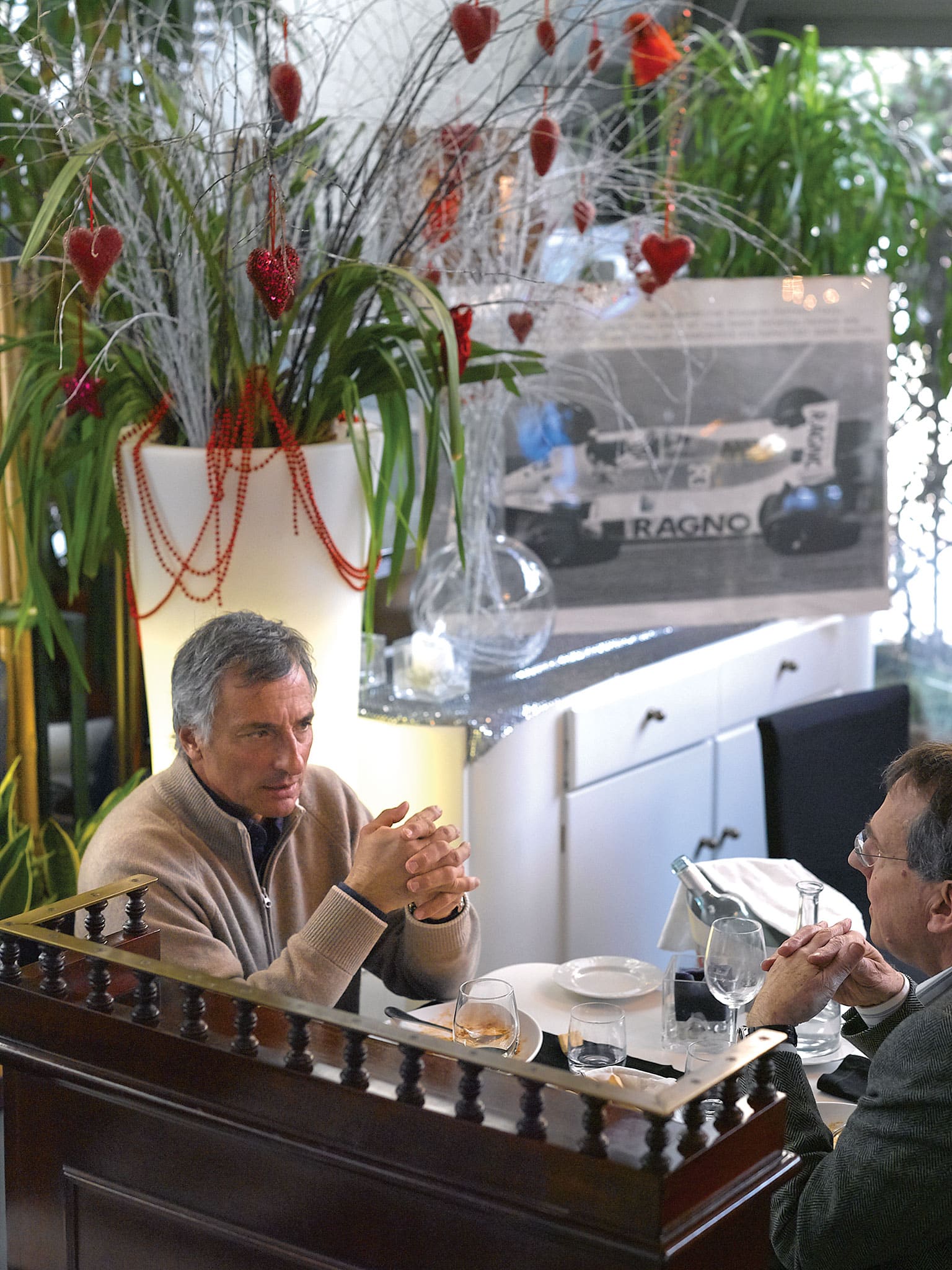
James Mitchell
Riccardo Patrese is an enigma. He was once seen as the Bad Boy of Formula 1, arrogant and wild, and so disliked by some of his fellow drivers that they threatened a boycott if he were allowed to race. Yet he remained in F1 for an extraordinary 17 seasons and 256 Grands Prix, a record until Rubens Barrichello topped it in 2008. Now he’s remembered not just as a talented and determined racer, but as a loyal team player and a man of integrity. In short, one of Formula 1’s rare gentlemen.
He still lives in Padua, the historic town in Northern Italy where he was born 56 years ago. The owner of the restaurant where we lunch, like half of Padua apparently, is a Patrese fan, and pictures of his greatest races adorn the walls. He’s always been a racer. As a boy he swam to competition standard, and could have represented his country as a skier had not karting intervened when he was 12. At once he showed real talent, winning races and national titles until, in 1974 at Estoril, he won the World Championship. Runner-up that year was a Rome-based teenager called Eddie Cheever.
“Once I was champion that was the finish of karting, and my mother, a language professor, was very relieved. Now I could go to university and be a normal boy. But a Formula Italia team had seen me karting and got in touch with my father, offering me a car. My mother was not happy: she knew my studies would suffer again. But my father said, ‘One more year, then he can go to university.’ So I did Formula Italia for a season, came second in the championship. Bruno Giacomelli beat me: he had more experience. But I had a lot of poles and I won some races. Then, again, I was going to stop.
“But Pino Trivellato came to me. He had just taken the Chevron concession for Italy, and he thought if he could put a young driver in an F3 Chevron and win a few races he would sell some cars. My first F3 race was at the old Nürburgring, 23 kilometres, and I had never seen it before. We arrived on Tuesday, to learn the track in our road car. But it was booked for the week by a tyre company, and we weren’t allowed to drive round. So I said, ‘OK, let’s look at the first bit.’ My friend and I, we walked down the first hill and up the other side. I was writing down notes about everything, like a rally navigator. And we kept going. After four hours we said, ‘Now we should go back.’ But by then it was as quick to go on as go back, so we walked on. I think the lap took us about eight hours. Then I went to bed and read through my notes, over and over.”
It worked. Against the cream of Europe’s F3 drivers Riccardo qualified third, finished a close second in Saturday’s national race, and led Sunday’s European Championship round. Then it started to rain and, driving sensibly on his slicks, he slipped to third. His first win came two weeks later at Zandvoort. That year he won the European F3 Championship, and the Italian title as well.
For 1977 Riccardo moved up to a Formula 2 Trivellato Chevron. He led the Easter Monday Thruxton race until slowed by a misfire and then, at the Nürburgring again, he galvanised everyone by taking pole in 7min 15.3sec, almost two seconds clear of local hero Jochen Mass.
He led the race, only to spin off under pressure from Mass, but the point had been made.
In the Shadow F1 team, Franco Ambrosio’s sponsorship required the second driver alongside Alan Jones to be Italian. But the incumbent, Renzo Zorzi, was proving slow. Jackie Oliver and Alan Rees of Shadow heard about the Nürburgring F2 race, and got in touch. “It was the Thursday, and Alan says, ‘Would you like to try F1? We have a day’s test at Paul Ricard on Monday.’ I did about 200 kilometres at Ricard, and half of it was wet. Then they say, ‘OK, this weekend we go to Monaco.’ A little bit strong, to do my first F1 race there.”
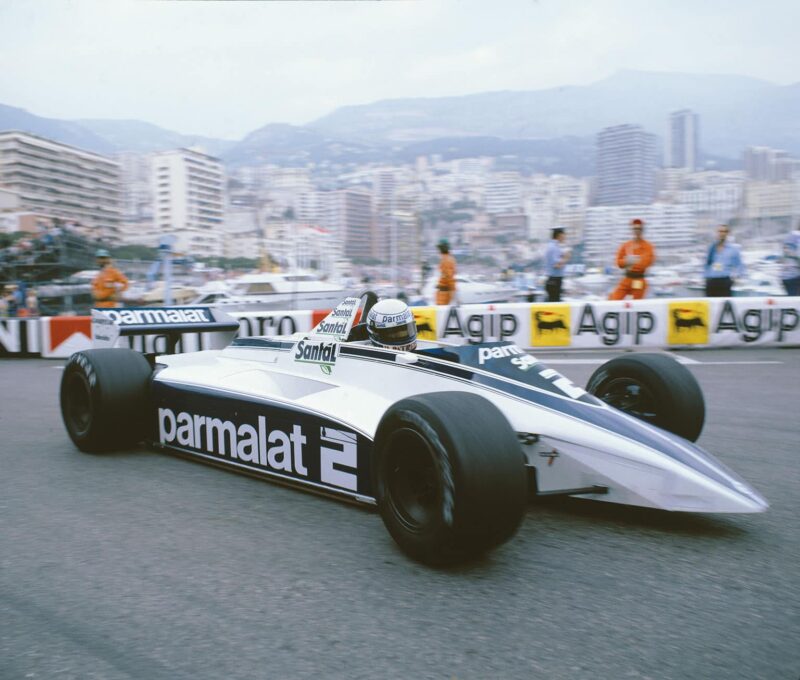
The first F1 win, after a fraught final few laps, in 1982
Motorsport Images
Riccardo qualified his Shadow 16th, less than half a second slower than team-mate Jones, and finished ninth, lapped only once by Jody Scheckter’s winning Wolf and Niki Lauda’s Ferrari. This fine drive confirmed his place in the Shadow team, but he found it a daunting experience. “I was 23, shy, very closed into myself. I didn’t speak English very well, and I found it difficult to communicate with F1 people and with journalists. That shyness was seen by many as arrogance, which it was not. And the well-established drivers tried to intimidate me. That first weekend in Monaco, every time one of the seniors was coming close I had to slow down and give them room, and when they came past they kept giving me the finger. They didn’t like young newcomers. When I had been in F1 a long time and a new driver came along, I would always try to be friendly with him, make him at home. In the 1970s it was not like that.”
Riccardo did eight more GPs that year, qualifying sixth at Monza, and scoring his first point in Japan. He still had his contracted F2 races for Chevron, too. “I went from the Japanese GP to the F2 Donington, then straight back to Japan for the F2 Suzuka, which I won, and then on to Macau, which I won as well. By now my mother had waved the white flag, and accepted that I wasn’t going to do my degree.”
Meanwhile Jackie Oliver had fallen out with Shadow boss Don Nichols and left to set up Arrows. Alan Rees and designer Tony Southgate followed him. “It all happened very quickly. I wasn’t really aware of the politics. At the same time Frank Williams was planning his own car for 1978, and approached both me and Alan Jones. Alan and I talked about what was going to happen, whether it was better to stay with Shadow, or go with Jackie’s new team, or take a chance with Frank, who’d been struggling with money and everything. In the end Jackie took me, because I was younger, and Alan went to Frank. In three years he was World Champion. I did get to Williams, but it was 10 years later! Arrows was going to be me and Gunnar Nilsson, but of course poor Gunnar got ill, and he never drove the car, so my team-mate was Rolf Stommelen.
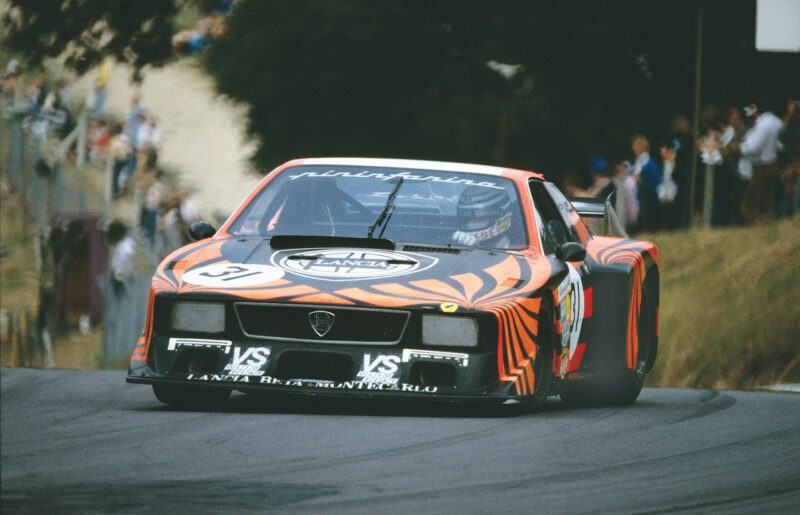
Sharing a Lancia Beta with Walter Rohrl in the 1979 Brands Hatch Six Hours
Motorsport Images
“The first Arrows was built in seven weeks, and when we flew it to its first race in Brazil it hadn’t turned a wheel, because Silverstone was under 10cm of snow. In practice in Rio the fuel wouldn’t pick up unless the tank was half full, so I qualified with heavy tanks, and in the race I had to stop for more fuel, but I finished 10th. So we knew that when we got the fuel system right the car would be quick. And it was. Second race, the South African GP at Kyalami, by lap 27 I was in the lead. It was a fantastic day, because it was only the team’s second race. I stayed in front until, with 14 laps to go, the engine blew. A very big disappointment.”
The Arrows was in the points at Long Beach and Monaco, and was lying second at Brands Hatch when a tyre punctured. Then Don Nichols won his copyright infringement case and Arrows had to switch hastily from the FA1 to the A1, which was not such a good car. It was in the FA1, in Sweden, that Riccardo finished second behind Lauda’s Brabham fan car, in its only outing before being withdrawn. In the closing laps the Lotus of Ronnie Peterson, who was fighting back after a puncture, caught the Arrows. “I had a battle at the end with Ronnie, and I was making my car very wide to hold onto my position. Ronnie complained to me afterwards, saying he was quicker than me and I had made my car very big. He was a nice guy and he was not really so upset. But my problems started with that race. Three months later came the Monza accident.”
In those days the job of starting an F1 race was usually given to a local official. The man at that year’s Italian GP switched on the red light, and then the green, much too early, while the rear rows of the grid were still coming into position. When those drivers realised the race was on they of course accelerated hard, without ever coming to a halt. As the grid got away Vittorio Brambilla’s Surtees, from the back row, was already level with James Hunt’s McLaren on row five. Ronnie Peterson, on the third row, was in the spare Lotus 78 (his 79 had crashed during the warm-up when the brakes failed) and he did not make a good start. In the words of one spectator, “the whole grid closed up like an accordion” and it was a recipe for disaster – particularly as the wide Monza straight funnels down into half its width before the first corner.
Patrese, immediately behind Hunt on the grid, got away well, and went to the right alongside Hunt, but he is adamant that he was well clear of the McLaren when he had to move left as the track narrowed. Photographic and video evidence later confirmed this. Hunt, interviewed a few days later, maintained that “Patrese barged over on me”. What is unarguable is that Hunt’s left front hit Peterson’s right rear, and the Lotus slewed sideways into the barriers and bounced back into the track, to be hit by other cars. In all 10 drivers were involved: Brambilla was struck by a wheel and badly injured. Peterson was dragged from his burning car by Hunt and flown to hospital with complex leg injuries, but was expected to survive. Tragically, early next morning he died.
The next Grand Prix was three weeks later, at Watkins Glen. In the interim the CSI – the FIA’s sporting commission in those pre-Balestre days – astonishingly made no official comment. But five drivers took matters into their own hands. Ronnie’s team-mate, the newly-crowned World Champion Mario Andretti, plus former champions Hunt, Lauda and Emerson Fittipaldi, and soon-to-be champion Scheckter, told the US GP organisers that if Patrese were allowed to run, they would boycott the race.
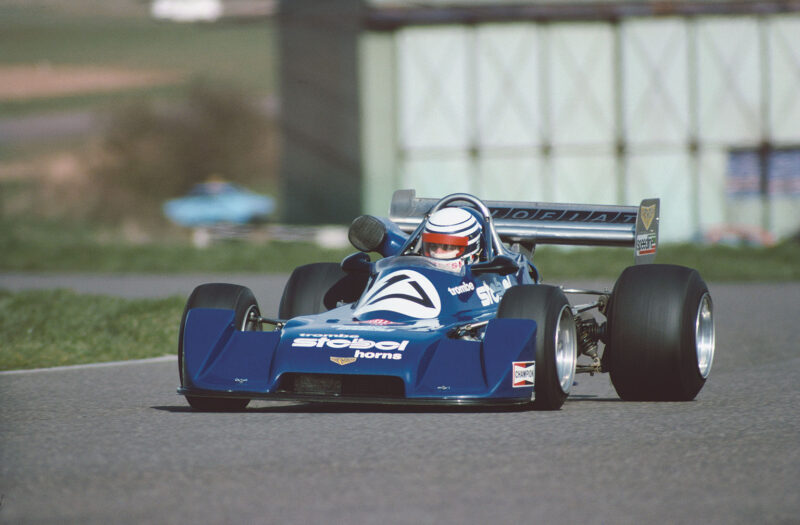
Leading at Thruxton in 1977 – star turns in F2 that led to his F1 breakthrough with Shadow
Motorsport Images
“They wanted to give me a punishment, because they said I had been too aggressive all year. I went to Watkins Glen to make my race, and Bernie Ecclestone said to me, ‘Look, some of the drivers are angry with you, so you have to say you were in the wrong, apologise.’ So I sat down in one of the motorhomes with the five drivers, and I tried to say sorry. The hardest was Mario. He had been very close to Ronnie and he really thought I had caused his death, because that was what Hunt was saying. I said I was sorry for what I had done in Anderstorp, and I tried to explain that in Monza I was in front of the accident and I hadn’t touched anybody. I went there with humility, hoping they would accept what I said. But they didn’t, and they said again to the organisers, ‘If Patrese races, we don’t race.’ They were champions, Andretti was at his home Grand Prix, I was a nobody. So I went into the town of Watkins Glen, got a hearing with the local judge and stated my case. The judge ruled that nobody could stop me doing my work, and gave me a piece of paper saying that. When I got back to the circuit, Jackie Oliver said, ‘Riccardo, we are a new team, we are under some pressure here. So we have withdrawn your entry.’ That was it, I could not race. A week later, at Montréal, nobody was saying anything now. I finished fourth.
“When somebody is killed in Italy they have a legal process, and both I and the starter, Gianni Restelli, were accused of the culpable homicide of Ronnie Peterson. In my case the process went on for three years. It was very unpleasant, but in the end the judges said there was no fault for me. Some more photos were found later that had been taken from the top of the tower at Monza, and they showed very clearly that I was well ahead when the accident happened. But James Hunt never changed his mind about me. When he was working as a TV commentator, he always said bad things about me. I went into Bernie’s motorhome one day, it was nearly 10 years later, and Hunt was there. Bernie said, ‘James, it’s time you made your peace with Riccardo.’ James said, ‘I have nothing to say to him’, and he got up and left.
“After I had led Kyalami Ferrari summoned me to Maranello, and Enzo signed an option on me for 1979. Of course, as an Italian, it was my dearest wish to drive for Ferrari. Then Bernie offered me a one-year contract for 1979, with a two-year option after that. But I was still hoping for Ferrari, so I said no to Bernie. I think some people in Ferrari wanted Gilles Villeneuve out because he had a lot of accidents, but Enzo always liked Gilles of course, and then he won Montréal at the end of the year, so he carried on with Scheckter for 1979. Enzo paid off my option and I stayed with Jackie Oliver.”
Riccardo did four seasons with Arrows. After finishing second at Long Beach in 1980 he put the A3 on pole there in 1981, and was leading comfortably when he was stopped by a blocked fuel filter. “After that there was contact from Maranello again: ‘We are having a new driver beside Villeneuve for 1982, and you are the driver we would like to have.’ But somebody inside Ferrari didn’t like me, and they took Didier Pironi instead. I know [sporting director Marco] Piccinini was pushing very hard for Didier. So then I did sign for Bernie for 1982.
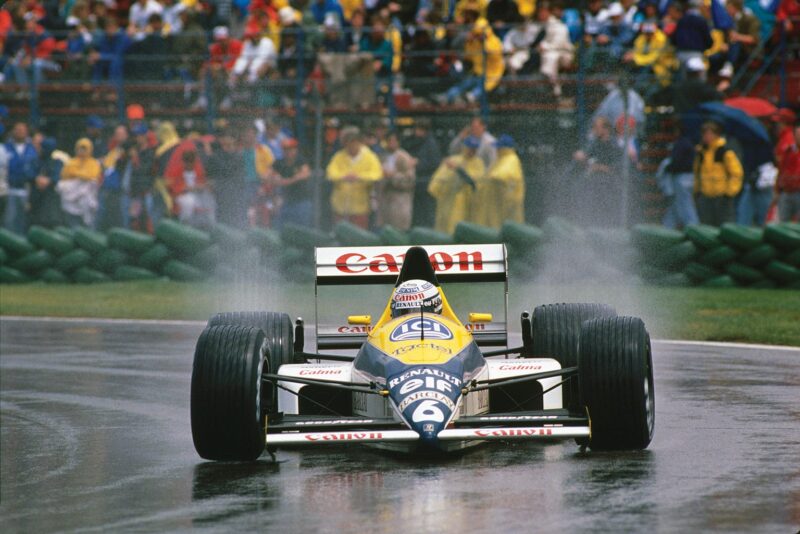
1989 brought Renault power to Williams, but also bad luck – a loose undertray cost victory in Canada
Motorsport Images
“Now, for the first time in my career, I had a really good car. Nelson Piquet had won the title for Brabham in the BT49C, and of course he was strong in the team, but he always made the atmosphere easy. The first time we tested together, at Paul Ricard, when I went to get changed at the end of the day I could not find my trousers. At Ricard they had those big high flagpoles, and Nelson had hoisted my trousers, they were flapping 20 metres up in the Mistrale. With Nelson everything was always a big joke.
“At Monaco I got my first victory at last, but it nearly went so wrong. I qualify second, and I am in second place behind Prost’s Renault. My pitboard says behind me is Pironi in the Ferrari, de Cesaris in the Alfa, Rosberg in the Williams. I have that order in my head. Four laps to go: the rain comes, and the lottery starts. Prost has a big accident at the chicane – it was fifth gear in those days, very quick. So I am in the lead, but the rain is heavy now. I am taking it very carefully, just a lap to go, and I come into the Station Hairpin. I touch the brake, I am doing 10kph, and it is like I am on ice, the car goes away and I spin. I cannot believe it. I am sitting in the car in the middle of the track, the engine has stalled. My first Grand Prix win, and I have thrown it away. A Ferrari comes by: that is Pironi. An Alfa: that is de Cesaris. A Williams: that must be Rosberg. The marshals pull me back because I am stalled across the apex, in a dangerous position. Now I am pointing downhill. The car rolls slowly towards Portiere, I push it in gear, and it starts. I am really fuming because I think I am fourth.
“I begin my last lap, and I pass de Cesaris, out of fuel. A bit better, I am third. Down through the tunnel, there is Pironi, parked. OK, I am second, but Rosberg must still be in front of me. I cross the line, the flag waves, everybody is cheering. But I am very upset, I lost a Grand Prix that should have been mine. On the slowing-down lap Pironi waves me down, he wants a lift back to the pits. I stop, he sits on the side, holds onto the rollbar, but I am still so angry I forget he is there and I accelerate first, second, third, fourth. By the time we got to Tabac he was banging on my helmet to slow down, so he could jump off. When I get to the pit entrance they wave me on to the royal box, and I don’t understand. No radios then, of course. I stop, and an Italian guy jumps in front of the car: ‘You won, you won.’ As I go up the steps to meet Princess Grace, only then do I understand I have won the Monaco Grand Prix.
“What I didn’t know was that Rosberg crashed several laps before. The Williams I had seen was Derek Daly’s. But for 20 years I still felt stupid for my spin at the hairpin. I could never understand why I spun at such a slow speed – until, quite recently, I read an interview with Derek Daly in Motor Sport. He said he crashed at Mirabeau, and broke his oil cooler. He drove on down to Station Hairpin, and all his oil was leaking everywhere. I had spun on his oil. But he did another lap, and when he came past I thought he was Rosberg. When I read that in Motor Sport, I felt better.
“Gordon Murray was so clever. After we had switched to the BMW turbo-powered BT50, Gordon dreamed up mid-race refuelling. The turbos needed 240 litres to go a race distance. With that much fuel on board at the start, the weight, the tyre wear – it was a disaster. He made a system that forced in 120 litres in a few seconds under high pressure, whoosh, and a big oven to heat up the new tyres. We tested it all at Donington, and the first time we used it was that August, in Austria. I was in the lead, and it went perfectly. I came in, four tyres and fuel – the first time it had been done in modern F1 – and back in the race without losing the lead. Incredible. Four laps later the engine blew…
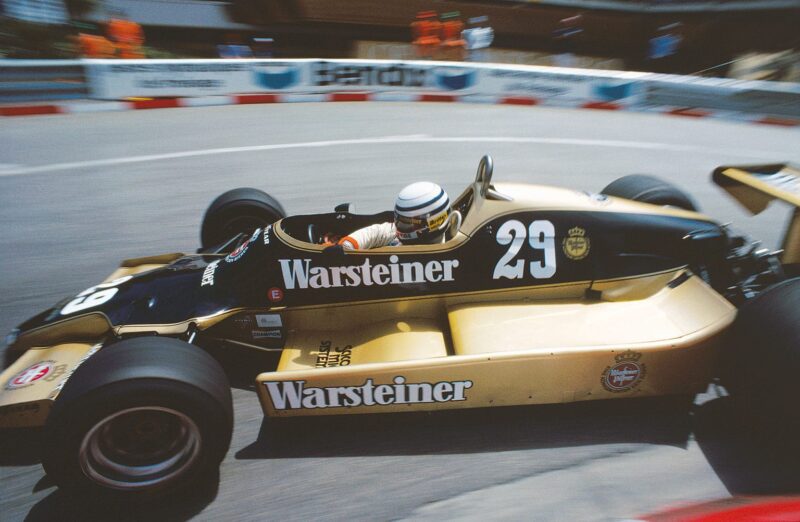
In the Arrows A1B at Monaco in 1979
Motorsport Images
“Imola in 1983 was a race I should have won. I led, then my pitstop was slow and Patrick Tambay’s Ferrari went ahead. Six laps to go, I get the lead back. And then I relax a little, I say to myself, OK, I have won this Grand Prix. At the Aqua Minerale corner the surface was breaking up, I put a wheel a few centimetres off-line, and I crash. The tifosi cheered: they prefer a Frenchman to win in a Ferrari than an Italian to win in any other car. I was so angry with myself I didn’t hear them cheering. But I saw it on TV when I got home, and it made me feel even worse. The tifosi can be very cruel.
“At Monza I had pole. Bernie said to me, ‘Nelson is fighting for the championship, will you help him today?’ I say, ‘Maybe, Bernie, but what about my contract for 1984?’ ‘I can’t tell you yet.’ ‘If Nelson is close to me I am not going to crash with him, but if I am a long way in front I am not going to slow for him, you can’t expect me to do that here, in Italy.’ Then Gordon asked me the same question, I gave him the same answer, and Gordon didn’t like it, he was very cross. ‘We are a team, you have to help Nelson.’ I said, ‘Don’t ask me this. We are in Italy, I am on pole position, I have no contract for next year. I won’t make trouble for Nelson, but if I can win this Grand Prix, I will.’ The race starts, and I can’t believe how much power my car has. It feels like a rocket, like it has an extra 100bhp. I go easy into the lead. Third lap, into Parabolica, boom! Did they put me in the race with qualifying boost? I didn’t say that to Gordon, because I couldn’t prove anything… but Nelson won.
“After that I helped Nelson. In the last round at Kyalami, he had to score three more points than Alain Prost to be champion. Nelson leads, I am second, and before half distance Prost is out. So Nelson starts to slow down. I slow down behind him. Does he have a problem? He goes slower, I go slower. I come beside him to look, he waves me past, Go, go. He wanted to save his car, to be sure to finish third for the championship. So I win the race, and he is champion again.
“October, November, Bernie is still saying, sure, sure, we find a solution, but no contract. So I sign for Alfa Romeo. Then Bernie says, OK, sign for me. Perhaps it was just because he knew I was no longer available! You never know with Bernie. But my two years at Alfa were a disaster. The team, Euroracing, did not have the budget to do things properly.” In two seasons, alongside his old karting team-mate Eddie Cheever, he had a podium at Monza and a fourth at Kyalami, but little else. “In 1985 the car failed everywhere, and I did not score a single point. I thought nobody would pick me up now. But Bernie wanted me back. And at the end of those two hard years at Alfa, I had changed a lot. I was easier with people, more relaxed. At 30 you become a man; before that you are a boy.
“Back at Brabham I was with Elio de Angelis. Before, maybe because we were both Italian, we had a rivalry, we were wary of each other. When we started working together our relationship became very good. But the car – Gordon’s low-line BT55, with the engine on its side – it was very difficult. You lie on your back with your neck angled forward to see where you are going, and you cannot breathe. The first time I tested it I did one lap and had to stop. And the sides of the body were so low you felt completely out of the car. We got used to it, and it had huge horsepower, but it was not easy. After Monaco it was my turn to test at Ricard, but Elio asked me to swap dates with him. He wanted to have more miles in the car before Spa, so I said, fine. In the Esses after the pits at Ricard, flat in sixth, I think something broke. The car turned over, caught fire with Elio inside, and people were slow to get there. In those days the marshalling and medical services at a test were not very good. It was a very, very sad accident. And, you know, it should have been me testing. Life is strange.
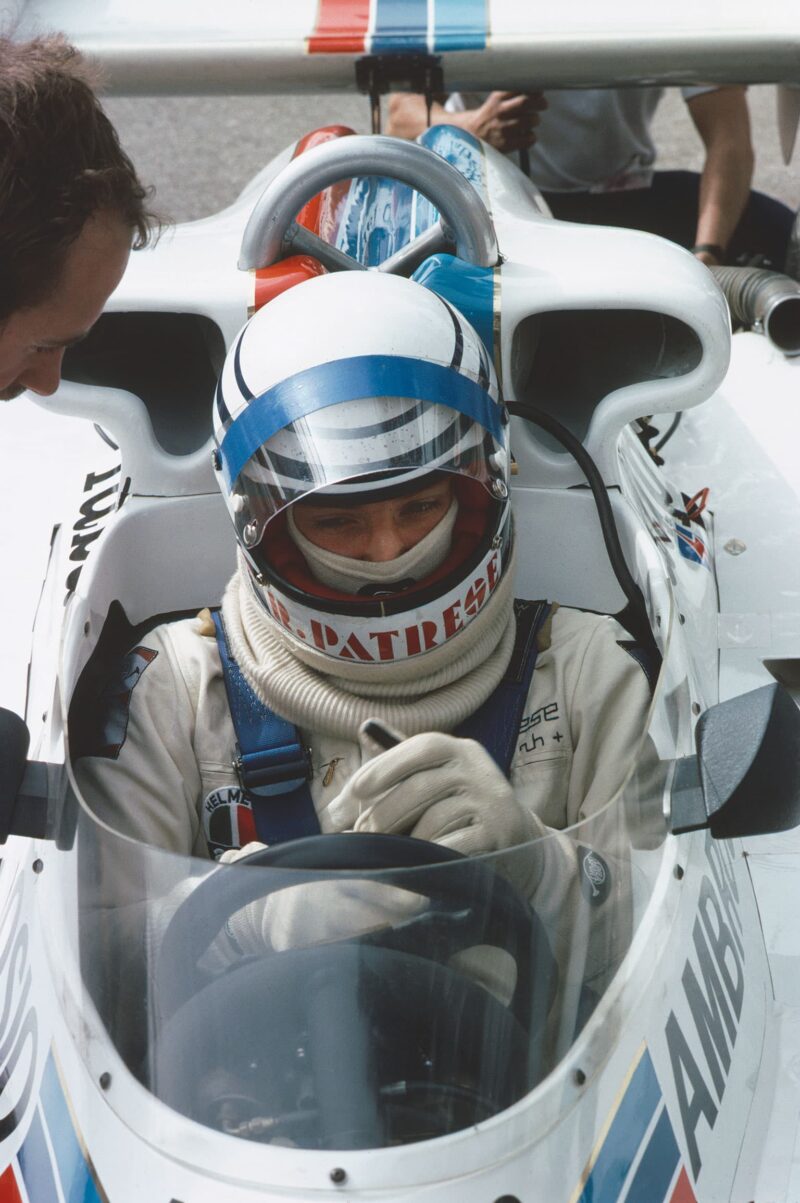
As a shy F1 newcomer with Shadow, Patrese struggled for acceptance
Motorsport Images
“Derek Warwick was my team-mate for the rest of that year – a fantastic guy – and for 1987 Andrea de Cesaris joined. I tried to persuade Bernie not to take him, but Bernie said, ‘It’s sponsorship, sponsorship.’ When Bernie wants to do something he does it. The reason I did not want Andrea was because of Brands Hatch in 1985, when we were both in the Lancia sports car team – it was late in the race, and we just had to cruise round to finish. But going up to Druids he tried to overtake me, drove into the back of me, crash! I had to make a pitstop, I was furious. But at Brabham, by the end, we were friends. He could be quick, too, but he was disorganised.
“I didn’t know Bernie was planning to sell Brabham at the end of the season. Nobody knew. But Bernie looked after me. In August he offered me to Frank Williams for a test at Imola. The FW11B was the best car that year, so it was a great opportunity. I did the two-day test, and went half a second quicker than Ayrton Senna’s Imola pole. Piquet was leaving for Lotus, and Williams signed me to join Nigel Mansell. Bernie was always a good friend to me. You don’t need a contract with him. If he looks you in the face and says he will do something, that is what will happen.
It was the start of five fantastic years for me at Williams. All my years in Formula 1 were good, because I had strong relationships with many good people, and even in the bad times I liked to work with the team to bring the morale up. I think that is why I survived for 17 seasons. But Frank and Patrick [Head] are special. Frank
is an extraordinary manager, Patrick is an extraordinary engineer. The first year, 1988, we only had the Judd engine, but for 1989 the Renault V10 arrived. Nigel had gone to Ferrari, and Thierry Boutsen was my team-mate. A good driver, a nice person too. The McLarens were very strong that year, but I had some bad luck.
I led in Rio but the engine broke. Then in the rain in Canada my undertray came adrift and I lost downforce; I let Thierry past, he won, I was second. And Hungaroring: pole, led for 52 laps, then a stone through my radiator. But Imola 1990 was great after my error in 1983, and this time the tifosi were cheering for me. I chased Berger’s McLaren and took the lead with 10 laps to go, scored my first F1 win for seven years.
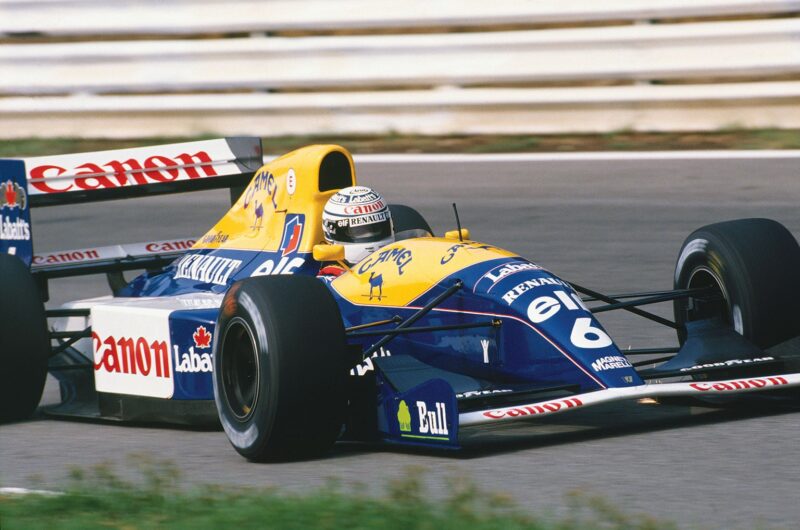
On winning form for Williams in Portugal in 1991
Motorsport Images
“In 1991 Nigel was back at Williams. To start with I was faster than him – I outqualified him for the first seven races, and took four pole positions. He was not happy with the handling of his car, and at one point he asked to try mine, but he found they were the same. By now we had telemetry, and it told us we were the same in fast corners, but my advantage was in the slow corners, I was getting more speed out of my car. After six races I was second in the championship to Senna. Then Nigel had four fine wins, and after that I helped him to try to beat Senna. In Portugal my car broke in qualifying, and I had to walk back to the pits. Patrick shouted to me to get in the T-car. I had never sat in it before, but I did one lap and set pole. I led the race, but then let Nigel by as I promised. But leaving the pits after his tyre stop a wheel came off, and after that he was black-flagged. So I won anyway.
“In 1992 we had the active suspension car, and Nigel was usually quicker than me. No power steering then, and because of the downforce loadings the steering became really heavy. He was stronger than me, more power in his arms. The car was much quicker in the fast corners, but with the heavy steering there was not so much feeling, and in the slow corners my advantage was gone, because now we had traction control to do the job for us.
“I always had a great relationship with Nigel – even though he was whingeing a lot! – and still now we are good friends. But I have just read the new book that Maurice Hamilton wrote about Williams. In there, Adrian Newey said that on the active car Nigel would get his cockpit settings correct in testing [the three knobs that adjusted the ride height front and rear, low speed and high speed] and then, on his in-lap, he would change the knobs so that when my engineer checked his settings we would get them wrong. David Brown, Nigel’s engineer, was in on the secret. I never knew. The active car was very complex, and everything I discovered in testing I put down on the table because we were a team. But it seems Nigel was doing something different.” As Adrian Newey says in the book, Mansell knew Patrese was a serious rival, and set about beating him any way he could.
“The active car suited Nigel better than me, and in that car he was quicker than I was. He deserved to win the championship. It is a shame he did not make his decision to leave Williams, and leave F1, until the Monza weekend. Because by then, believing there was no longer a place for me at Williams, I had signed for Benetton. Frank asked me to stay, but I had given my word to Alessandro Benetton. Flavio Briatore said he had to have me, he could not live without me, because of my knowledge of the active Williams. But after three or four races Mr Briatore was saying I was not quick enough, it was time for me to go to pension. There were a lot of problems with the car, but I wasn’t complaining publicly, I was just talking to the team and trying to solve them. And Michael Schumacher is very good in a bad car, that is where he can destroy his team-mate. I was talking inside the team about the faults the car had, but they said I was just making excuses, because Schumacher was quicker than me.
“In fact by mid-year they discovered a bad problem with the car, they realised I had been right, and suddenly it became much better” – whereupon Riccardo finished in the points five races running, with second in Hungary and third at Silverstone. “But Briatore still wanted me to go. With Michael I always got on well. As we know now, he was special. After me Verstappen, Lehto, Herbert, none of them found it easy racing with Schumacher.
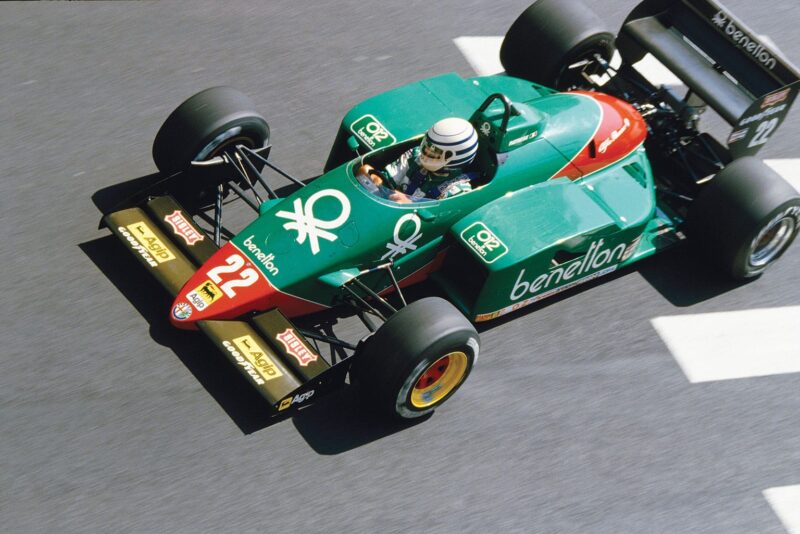
Alfa years were a disaster, but a return to Brabham saved his career
Motorsport Images
“Right up to 1992 I was as motivated in F1 as I had been in 1977. But at the end of ’93 I was waiting to leave Benetton, because I did not like Briatore. After 17 years I was out of F1, and when the ’94 season started and I was at home watching it on TV it felt bad. I went to qualifying at Imola, to see old friends, and talk to Frank and Patrick about doing some testing for Williams, just to help with the car development. They said, ‘Good idea, Riccardo, we’ll organise it.’ I said goodbye to Ayrton and went home, watched the race next day on TV. And Ayrton died.
“I knew him well. We had a good friendship, spent holiday time together on an island between Japan and Australia. As a person he had a lot of charisma, always acted very still and quiet. Suddenly I realised there was maybe a possibility of racing again, but all I had was a big pain in my heart, because of Ayrton. Two weeks later I saw Frank and Patrick at Monaco, and they said to me: ‘If we offered it, would you come back to race?’ And I said, ‘Yes, if you want me, I will come back.’ When I got home all the Italian journalists were calling, saying they knew I was going to Williams in Ayrton’s place. They were pushing hard. Another journalist called and said, ‘It’s true, isn’t it? You are going to Williams.’ In that moment I decided. I said, ‘No. I am not. F1 is over for me.’ I called Frank straight away, and said, ‘Maybe you were not going to choose me. But in any case, I have decided to say no.’
“I did drive a Williams again. In 1996 Frank and Patrick asked me to come to Silverstone to test the FW18, Damon’s and Jacques’ car which dominated that year. It was a gift from old friends. I hadn’t been in a single-seater for three years, but it was the most enjoyable test of my life. No pressure, no programme: just go out and enjoy myself. The first day I got myself settled in, the second day I put on a couple of new sets and pushed. My best lap would have put me on row two for the British GP. But that car was so good, you could get in and go well at once.
“In 2005-06 I did the GP Masters. I thought, OK, it’s just a parade, we wave to the crowd. But we get to South Africa and the fever is back for all of us. I was 51, but I had never stopped going to the gym. The cars were quick, but simple, nothing to adjust, and the rules were strict. They weighed all the drivers, and the lighter drivers took extra fuel to make it equal. In the weighing De Cesaris was discovered with heavy spanners in his pockets, to get a tiny advantage! It was funny, everybody still so competitive. At Kyalami Nigel won, Emerson was second and I was third, and we were all racing hard. It was a shame the Masters did not work commercially, because it was fun.
“Besides single-seaters, I did nine seasons with Lancia in sports cars. My co-drivers were good people – Sandro Nannini, Walter Röhrl, Michele Alboreto, Bob Wollek, Teo Fabi. We won a lot of races: Watkins Glen, Brands Hatch, Nürburgring, Kyalami, Spa. But I never liked Le Mans. I felt I was a sprint racer, and in a six-hour race, or 1000 kilometres, you would do maybe three hours each and drive flat out. Le Mans was not like that. I also did German touring cars, but I didn’t like it. The technique is very different, no downforce, and to win you have to be a category specialist.”
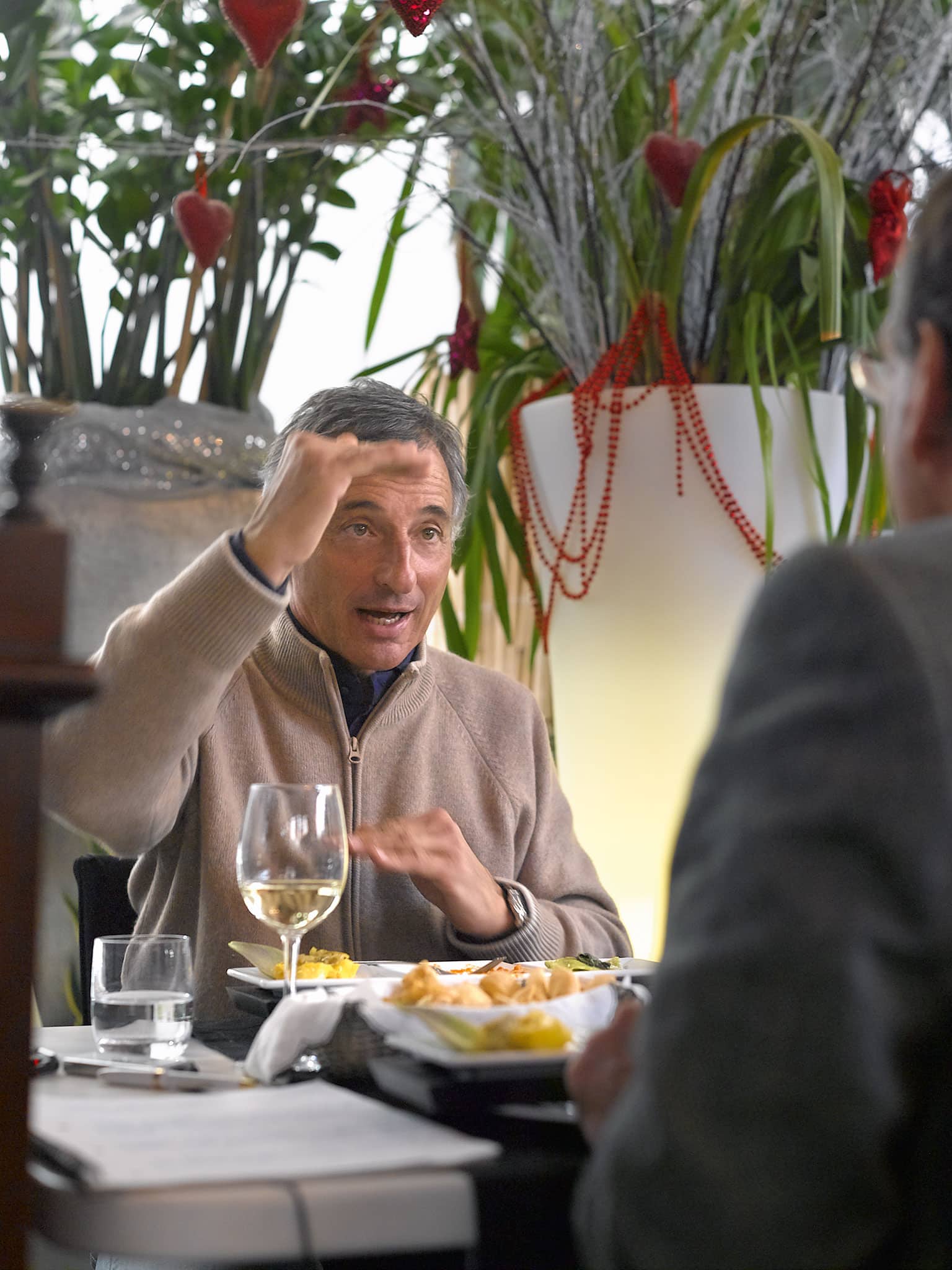
Still very fit and active, Riccardo now concentrates on skiing, tennis, golf – and horse riding, in the hoofprints of his daughters who are international-standard show jumpers. “It is my passion now. The biggest accident I had in my life was not in F1, it was falling off my horse.” In Padua he remains a local hero, while in F1 he is remembered as a charger who believed that motor racing was, and should remain, a sport. After 17 long years in the Formula 1 circus, that’s not a bad legacy.
